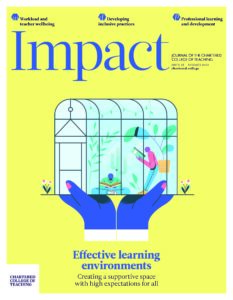Connecting to school and each other: Towards a new paradigm of a school response to mental health
Written by: Colleen McLaughlin

9 min read
Colleen McLaughlin, Emeritus Professor of Education, University of Cambridge, UK
Where are we now? The landscape of mental health and schools
The lesson is that the goals of schooling must include social features as well as the transmission of information.
(Rutter, 1991, p. 8)
We have known for a while that school has a significant impact on young people’s later development, quality of life and mental health, and is especially important for socially, academically and emotionally vulnerable young people. Rutter’s (1991, p. 9) research demonstrated the protective role of schooling and the danger of splitting the cognitive and social elements of schooling, as both these features impact on scholastic attainment and ‘influence what happens afterwards in a child’s life in a complicated set of indirect chain reactions’. Key elements in good school experiences develop self-efficacy, meaning ‘People's beliefs about their capabilities to produce effects on their life and cont
Join us or sign in now to view the rest of this page
You're viewing this site as a guest, which only allows you to view a limited amount of content.
To view this page and get access to all our resources, join the Chartered College of Teaching (it's free for trainee teachers and half price for ECTs) or log in if you're already a member.
- Bandura A (1994) Self-efficacy. In: Ramachaudran VS (ed) Encyclopedia of Human Behavior, Vol. 4. New York: Academic Press, pp. 71–81.
- Chen G, Gully SM and Eden D (2001) Validation of a new general self-efficacy scale. Organizational Research Methods 4(1): 62–83.
- Department of Health and Social Care (DHSC) and Department for Education (DfE) (2017) Transforming children and young people’s mental health provision: A green paper. Available at: www.gov.uk/government/consultations/transforming-children-and-young-peoples-mental-health-provision-a-green-paper (accessed 20 March 2022).
- Dweck CS (2000) Self-Theories: Their Role in Motivation, Personality, and Development. London: Routledge.
- Dweck CS (2017) Mindset. London: Robinson.
- Goodenow C and Grady KE (1993) The relationship of school belonging and friends’ values to academic motivation among urban adolescent students. The Journal of Experimental Education 62(1): 60–71.
- Gray J, Galton M, McLaughlin C et al. (2011) The Supportive School: Wellbeing and the Young Adolescent. Newcastle Upon Tyne: Cambridge Scholars Publishing.
- Gustafson et al. (2010) Schools, Learning and Mental Health: a systematic review, Stockholm: The Health Committee, The Royal Swedish Academy of Sciences.
- McDermott T, Porter J, Ingram J et al. (2020) The development of a tool for investigating the barriers and supports to participation in school life and feelings of belonging: Part 1. European Journal of Special Needs Education 36(5): 787–802.
- McLaughlin C and Clarke B (2010) Relational matters: A review of the impact of school experience on mental health in early adolescence. Educational & Child Psychology 27 (1): 95–107.
- OECD (2021) Beyond Academic Learning: First Results from the Survey of Social and Emotional Skills. Paris: OECD Publishing.
- Public Health England and Department for Education (DfE) (2021) Promoting children and young people’s mental health and wellbeing. A whole school or college approach. Available at: https://assets.publishing.service.gov.uk/government/uploads/system/uploads/attachment_data/file/1020249/Promoting_children_and_young_people_s_mental_health_and_wellbeing.pdf (accessed 20 March 2022).
- Rutter M (1991) Pathways from childhood to adult life: The role of schooling. International Journal of Pastoral Care in Education 9: 3–10.
- Santini ZI, Pisinger VSC, Nielsen L et al. (2021) Social disconnectedness, loneliness, and mental health among adolescents in Danish high schools: A nationwide cross-sectional study. Frontiers of Behavioural Neuroscience 15: 632906.
0
0
votes
Please Rate this content
Please login to comment
0 Comments
Oldest
Newest
Most Voted
Inline Feedbacks
View all comments










